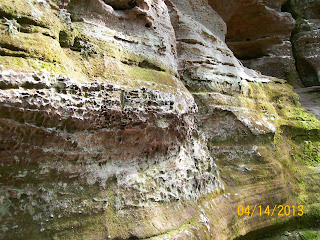Now to let the pictures do the talking.
I knew I was at the right place when I saw this.:
I had stopped off at Old Man's Cave too on this trip and at that place I was able to pick up a Hocking State Park guide. I was glad I had since there really wasn't much here as far as facilities went.
I followed the trail to the Rock House by going along the upper edge. As I recalled it was a loop around with the path going along the upper edge and then looping back through the caves and then ending back at the parking lot. I knew there were hills to climb and thought it best to do it first while I was still rested from driving and not all tuckered out from hiking.
I did recall having to be very careful while walking along the edge because the drop-off is more severe than it appears at first.
Its a pretty hike and really wasn't too bad to do.
I got excited when I started to see the Blackhand Sandstone jetting out like this and forming those cliffs. The Blackhand Sandstone is a member of the Cuyahoga Formation, deposited during the Mississippian Period about 350 million years ago.
The one thing I remembered most about this area was the jointing you would see. http://en.wikipedia.org/wiki/Joint_%28geology%29
You really couldn't call them faults because there was very little displacement along them but the formation would definitely have a crack running through it which would channel water also through it. The water would scour the cracks widening them with time so that they could become vary visible. Like this one.
 |
| Joint in the Blackhand sandstone, Hocking Hills State park Ohio |
One of the things that the Hocking Hills state Park is famous for is Honeycomb weathering.
http://en.wikipedia.org/wiki/Honeycomb_weathering
Because of this weathering the assumption is that this rock formation was deposited in an intertidal area. From other things I've observed and read the Blackhand Sandstone formation is believed to be an ancient deltaic system.
The colors are a lot more vivid than what the camera captured. I could auto enhance them but then it takes away from its natural beauty. The green moss also adds a lot to the color of the rocks.
This doesn't look like much but it is one of the openings to the Rock House.
 |
| Blackhand Sandstone cliffs of Rockhouse - Hocking Hills State Park, Ohio |
I just loved the way the rocks look in these pictures.
These were the rocks that were forming the ledge and were the caprock in the area.
I was surprised to see how much of a drop-off there still was after having climbed down to the rock house area.
Just look at these red streaks and green moss on the rocks.
 |
| Joint in Rock House - Hocking Hills State Park, Ohio |
Look at the way the joints go through them and have widen with time.
After oohing and googling the rocks outside I finally ventured into the actual area that is called the 'Rock House". According to the guide - The Rock House is considered the only true cave in the area. It is located midway up the 150 cliff of the Blackhand Sandstone in the middle zone area. The ceiling is 25 feet high and the corridor is 200 feet long with a width varying from 20 to 30 feet wide.
The ceiling and floor are the two more resistant zones of the Blackhand sandstone while the middle section is the less resistant zone. There is a joint going the length of the ceiling that allowed the water into this area to weather it out. There is also small joints going into the side of it that allow light in and gives it an appearance of a Medieval church. Because of its nature the place has been used as a hide out for robbers and a settlement for Native Americans.
I could tell by looking at this that at one time there was more water running thought it and the water was at a higher level. Most likely that occurred when the glacier were present just north of this area. There is no evidence the glacier where in this area but the run off was.
 |
| Inside the RockHouse - Hocking Hills State Park, Ohio |
 |
| Inside the Rockhouse - Hocking Hills State Park, Ohio |
Here's one of the cross cutting joints that let the light into the area and giving it a reverent feeling to the place.
just walking and taking the pictures the joint area can get a totally different look to it.
Through the years you could tell a lot of graffiti had been done on the walls. I hope people would learn not to destroy places like this. It should be for everyone's enjoyment.
A different area that had opened up.
The rockdawg in me liked this one a lot. I thought it look like a dog.
Here's a different view and closer up.
When I came out this is what you looked down on and you had to be very careful in picking up the trail again.
I just found the cliff walls so captivating to look at.
The other entrance to the Rock House.
This is what the other side of the gorge looked like. Very similar to the Rock House.
I got up to the parking lot and finally found the sign that was for the lower trail to the Rockhouse.
Here's some more information about the area
http://hockinghills.com/rock_house.html
http://en.wikipedia.org/wiki/Hocking_Hills_State_Park
http://parks.ohiodnr.gov/hockinghills
http://www.hockinghillsnews.com/news.php
http://www.americanbyways.com/listing/hocking-hills/
http://www.explorehockinghills.com/
.....















.JPG)
.JPG)



























































































